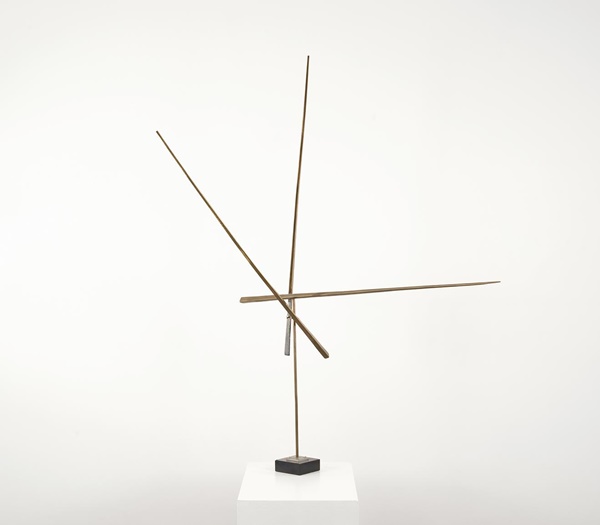George Rickey

TAGGART HOLLIS
521 W 26th Street, 1st Floor, New York, NY 10001T: +1 212.628.4000 e-mail:
Multiple location : New York NY Southport CT




September, 2022

Unstable Axis—Bronze, created in 1971 is a unique, prototypical sculpture. This rare example is fabricated in an experimental alloy metal most likely a mixture of lead and steel which develops an individual patina. The work exemplifies George Rickey's work of the late 1960s and early 1970s. During this period, his pieces grew taller and began to incorporate long slender arms attached to a central post. A slight breeze causes the arms to slice through air like blades in graceful arcs, activating the surrounding space. To invite and maximize movement, Rickey "calculate[d] the perfect point of balance—that with the least amount of friction on the pivot." (1) In 1961, he had invented "reverse knife-edge bearings" for his pivots, which allowed his lines to move freely in an arc from any starting position. (2)
Like the work of Alexander Calder, Rickey's kinetic sculpture captivates attention with moving parts in delicate balance. Yet, Rickey's precise geometry and formal concerns connect with the Constructivist tradition, while Calder's curved organic shapes owe more to Surrealism. Rickey chose not to include motors in his sculpture and instead relied on air currents to imbue his work with an element of unpredictability. He noted that his sculpture "parodied the machine age in its treatment of materials; its precision, its invention." (3) While his work, usually in metal, looks sleek and industrial, Rickey regarded it as thoroughly non-utilitarian, intended primarily to provide visual enjoyment.
George Rickey was born in 1907 in South Bend, Indiana, but grew up in Europe after his father, an engineer who worked for the Singer Sewing Machine Company, was transferred to Scotland. Rickey earned a history degree at Oxford, then moved to Paris to study art at Académie Lhote and Académie Moderne. During World War II, Rickey served in the Army Air Corps, where he worked in a machine shop to improve aircraft weaponry and discovered a love for solving mechanical problems. In the late 1940s, Rickey studied Bauhaus teaching methods at the Institute of Design in Chicago, which sparked his interest in geometric form and movement. He was particularly inspired by a lecture by visiting artist Naum Gabo about space and the elimination of mass. Rickey received a Guggenheim Fellowship in 1961 and had solo shows at the Phoenix Art Museum, Corcoran Gallery, and the Walker Art Center, as well as numerous galleries in the United States and Europe. In addition, his public art commissions appear in spaces around the world including Germany, Hawaii and Japan.
1. Hayden Herrera, "George Rickey," in George Rickey in South Bend, p. 12.
2. Nan Rosenthal, George Rickey (New York: Harry N. Abrams, 1977), p. 62.
3. Debra Bricker Balken, "George Rickey and 'The Poetry of Space,'" in George Rickey: Selected Works from the George Rickey Estate, exh. cat. (New York: Marlborough Chelsea, March 13 – April 12, 2008), p. 2.
Like the work of Alexander Calder, Rickey's kinetic sculpture captivates attention with moving parts in delicate balance. Yet, Rickey's precise geometry and formal concerns connect with the Constructivist tradition, while Calder's curved organic shapes owe more to Surrealism. Rickey chose not to include motors in his sculpture and instead relied on air currents to imbue his work with an element of unpredictability. He noted that his sculpture "parodied the machine age in its treatment of materials; its precision, its invention." (3) While his work, usually in metal, looks sleek and industrial, Rickey regarded it as thoroughly non-utilitarian, intended primarily to provide visual enjoyment.
George Rickey was born in 1907 in South Bend, Indiana, but grew up in Europe after his father, an engineer who worked for the Singer Sewing Machine Company, was transferred to Scotland. Rickey earned a history degree at Oxford, then moved to Paris to study art at Académie Lhote and Académie Moderne. During World War II, Rickey served in the Army Air Corps, where he worked in a machine shop to improve aircraft weaponry and discovered a love for solving mechanical problems. In the late 1940s, Rickey studied Bauhaus teaching methods at the Institute of Design in Chicago, which sparked his interest in geometric form and movement. He was particularly inspired by a lecture by visiting artist Naum Gabo about space and the elimination of mass. Rickey received a Guggenheim Fellowship in 1961 and had solo shows at the Phoenix Art Museum, Corcoran Gallery, and the Walker Art Center, as well as numerous galleries in the United States and Europe. In addition, his public art commissions appear in spaces around the world including Germany, Hawaii and Japan.
1. Hayden Herrera, "George Rickey," in George Rickey in South Bend, p. 12.
2. Nan Rosenthal, George Rickey (New York: Harry N. Abrams, 1977), p. 62.
3. Debra Bricker Balken, "George Rickey and 'The Poetry of Space,'" in George Rickey: Selected Works from the George Rickey Estate, exh. cat. (New York: Marlborough Chelsea, March 13 – April 12, 2008), p. 2.
 | George Rickey | |













